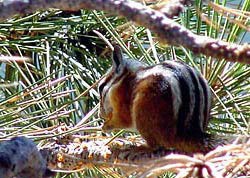
NPS Photo Size (length and weight): 8 to 9.5 inches (20 cm to 24 cm) nose to tail; 1.8 to 2.6 ounces (51 to 74 g) Habitat: Common forests and shrublands throughout the western U.S. In Utah, they are generally associated with ponderosa pine forests but may also be found in pinyon-juniper brushland at lower elevations. Diet: Omnivore; Diet includes fungi, leaves, fruit, flowers, seeds, pollen, buds, insect larvae, and eggs of various birds Predators: hawks and other raptors, jays, coyote, weasels, foxes, badgers, bobcats General Biology:The Uinta (sometimes spelled, Uintah) Chipmunk is a medium sized rodent. In the summer months, the Uinta Chipmunk are usually a yellowish brown-gray to dark brown. They have wide brown to dark brown stripes on their backs alternating with white stripes. The outermost stripes are white or a lighter brown. The winter coat of the Uinta Chipmunk becomes duller and more gray in color while the while the stripes become less distinct. The Uinta Chipmunk is distinguished from the Golden-Mantle Ground Squirrel by its smaller size and the stripes around its eyes which the Golden-Mantle Ground Squirrel doesn’t have.Behavior:Uinta Chipmunks are found throughout the western U.S., from Colorado to eastern California, north to southern Montana and south to northern Arizona. Uinta Chipmunks are territorial with a range of 5 to 12 acres (2 to 5 hectares). Their dens are usually found in sheltered and secluded areas often under shrubs or rock ledges. Uinta Chipmunks are diurnal, meaning that they are active throughout the daylight hours. During the summer months, they will often be seen foraging, filling their cheeks with materials to store for their winter survival. They will enter their dens for the winter in October and go into a state of torpor, waking up every several days to feed on food they stored through the summer. They will exit their hibernation state in May. Mating season begins in April and generally ends in June. Females produce one litter each year with pregnancy lasting about 30 days. Litters will be 4-5 “pups”. The pups become independent in 1 to 2 months.Conservation:The Uinta Chipmunk is common throughout its range. While there are no active efforts to protect the species, visitors to Bryce Canyon National Park should not feed any wildlife they may encounter while visiting the park. Feeding any wild animal may lead to disease for the wildlife or injury to humans. When wildlife is fed by us, they become dependent and a nuisance to others who may want to enjoy the park. When to see at Bryce Canyon:Uinta Chipmunks may be seen throughout the summer season in the forests and prairies of the park. |
Last updated: July 21, 2024
